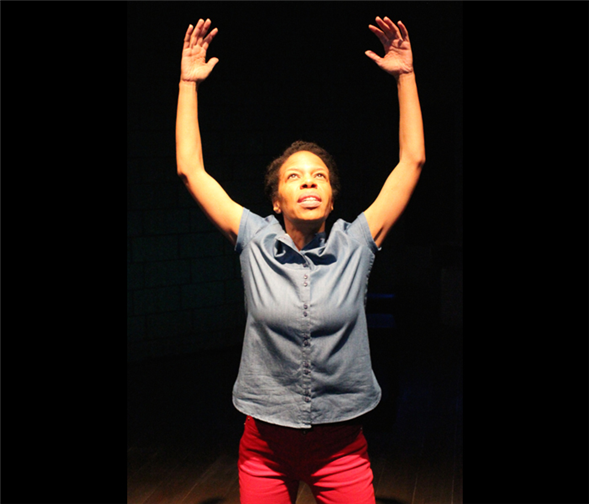Translate Page

In her new solo show, Nilaja Sun creates a universal neighborhood
---
Think of it like the iris in a camera or your eye, slowly opening to reveal more and more of the world. In her one-woman play Pike St., writer-performer Nilaja Sun begins with a hyper-focused story that's deeply rooted in Manhattan's Lower East Side. Then, as she embodies more and more characters whose lives overlap on the night of a ferocious storm, she lets us see how these particular New Yorkers embody the grace, love, and perseverance that communities around the world constantly muster to overcome hardship. Eventually, Pike Street feels like it runs through every city on the map.
Sun paints this large picture by taking care with small details. Creating a LES family and the galaxy of people around them, she gives everyone a distinct posture, speaking voice, and perspective on the world. (She does this with just her body and her writing. As in her previous solo play No Child…, Sun doesn't use props or costume pieces to distinguish between the roles she's playing.)
The play feels incredibly specific even before it begins. As they enter the Abrons Arts Center, where Epic Theatre Ensemble is presenting Pike St. through December 6, audience members see Sun sitting in chair. Her body is gnarled, letting us know her character has suffered some kind of debilitating attack. She stares intently into the middle distance, and since we hear the local news playing through speakers, warning of terrible weather, we can assume she's watching TV.
But more importantly, we can tell the character is alive. She may not be moving much, but she burns with focus, and if a recent performance is any indication, she demands rapt attention from patrons who might otherwise be checking their phones.
It's no accident that this is the first person we see. This, after all, is Candace – a teenager who has been incapacitated by a brain aneurysm. As the play progresses, Sun portrays Candace's mother, who is studying the healing arts in order to help her child; her uncle, who is just back from serving in the military; her grandfather, who is remarkably feisty for his age; and a variety of friends and neighbors. But they're all in Candi's orbit.
"It's nice to have the audience absorb Candi and have Candi absorb the audience before the show," Sun says. "It's important to know that you're walking into someone's world. It's important for people to get acquainted with the outside image of Candi – her physical reality right now – so that we, as an audience, know whose world it really is. And then when you do see her inner life, there's so much more going on than you might have thought."
{Image1}
We do indeed see flashbacks to Candi's bright past, when she was a promising young woman with a dream of joining Congress. Scenes like these add flavor to the play's portrait of the Lower East Side, which widens the show's scope beyond the family's apartment.
Sun herself was born to write about this neighborhood. She was not only raised there, but also did her first acting work at the Abrons Arts Center. "I'm literally from two blocks away, so when I leave my dressing room to walk to the stage, I can see my building," she says. "I had a lovely childhood growing up there, with all of the diversity, and the folks who are just doing it. They're not even caught up in the diversity, actually. They're living life. They're working hard."
To that end, Sun's characters include people from a wide variety of ethnic backgrounds, and she hopes this will help audiences remember that the Lower East Side is a melting pot to be celebrated. There are also political reasons for setting the play during a storm, particularly since characters like Candi can't easily flee. As Sun explains, "If, God forbid, the next hurricane happens or the next snowstorm happens, maybe my piece has struck a part of your heart where you remember, 'Oh, that's right. There are people who are living in tenement walk-ups who are disabled, who are elderly, who maybe can't get to the shelters.' These are people we have to think about."
And that sentiment points to an all-encompassing theme – that people are worth thinking about. That families and neighborhoods and communities contain the seeds for remarkable acts of generosity, if we can just remember to nurture them. We see someone like Candi; we see the people around her; we see them banding together in a crisis. Perhaps we see something we recognize. "Leadership comes in so many different forms," Sun says. "Life does not end until it ends, and you never know what the next corner is going to look like."
---
TDF Members: Click here to see our discounted tickets for theatre, dance, and concerts
Follow Mark Blankenship at @IAmBlankenship. Follow TDF at @TDFNYC.
Photos by Melissa Friedman